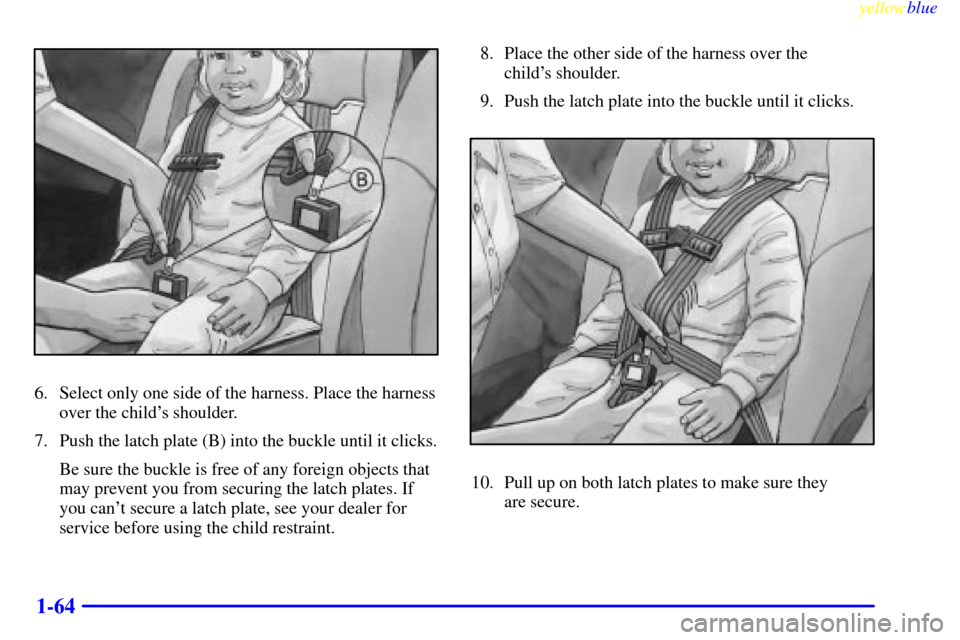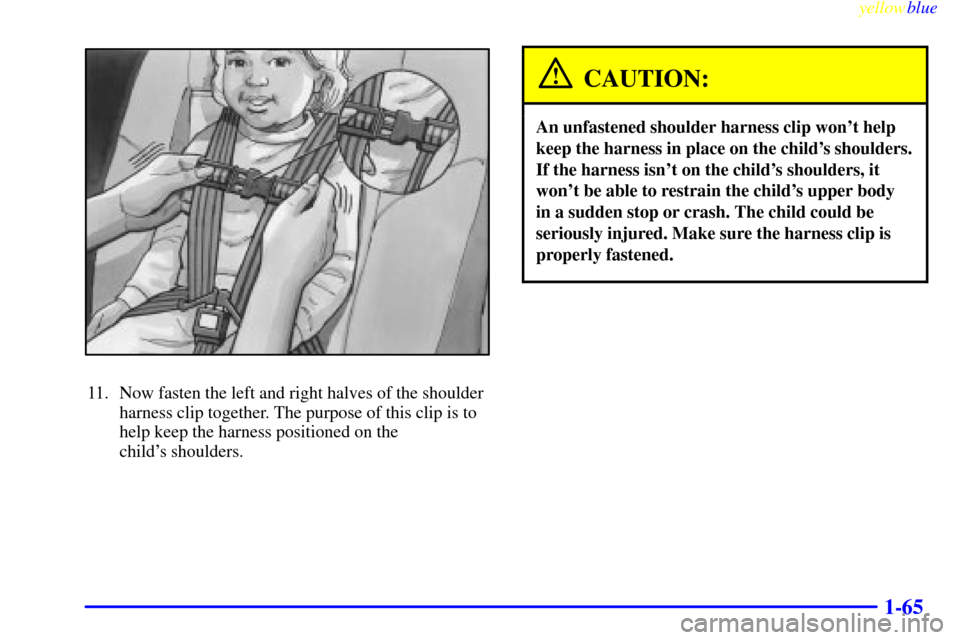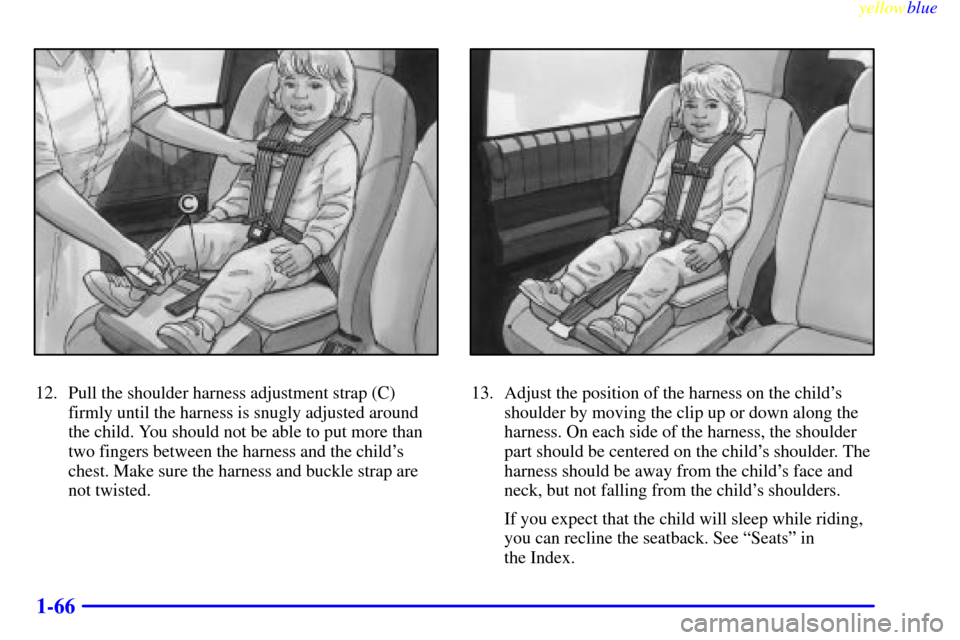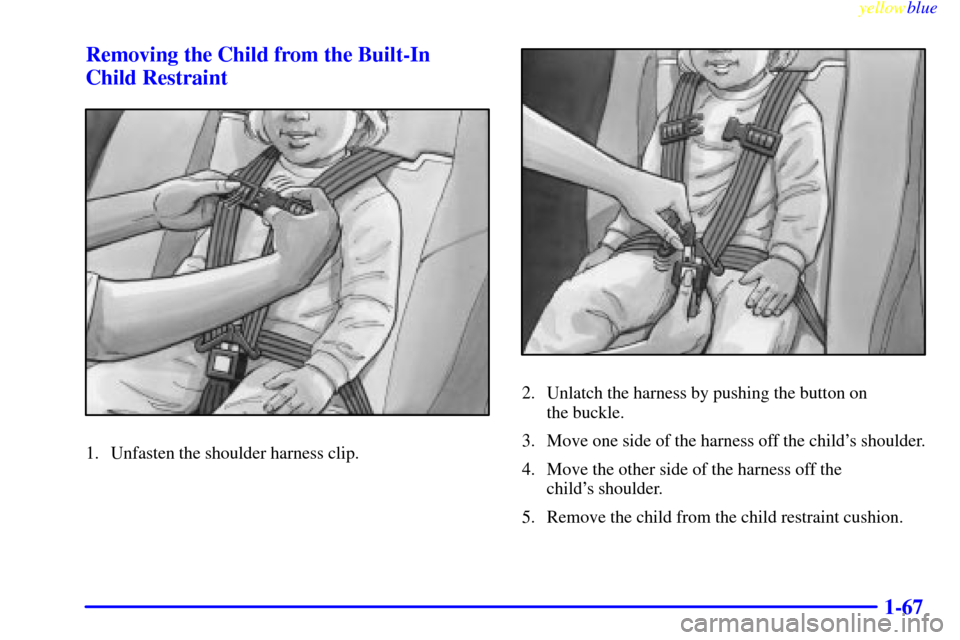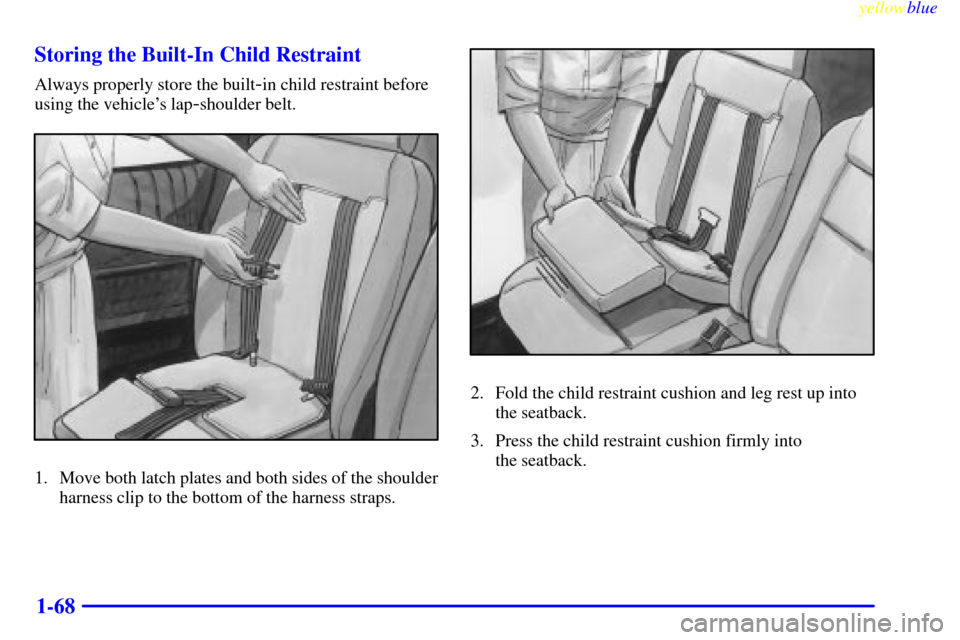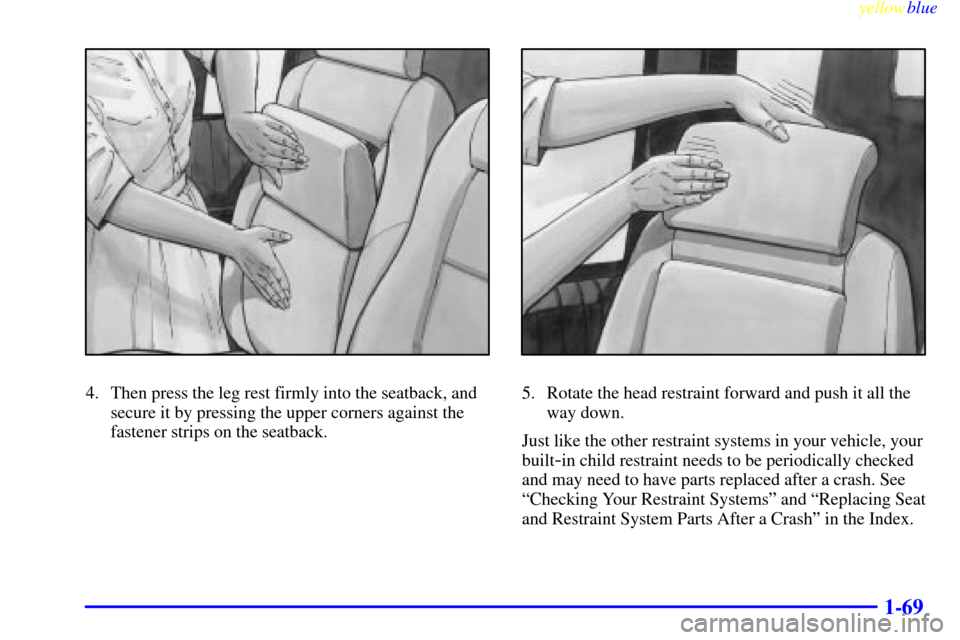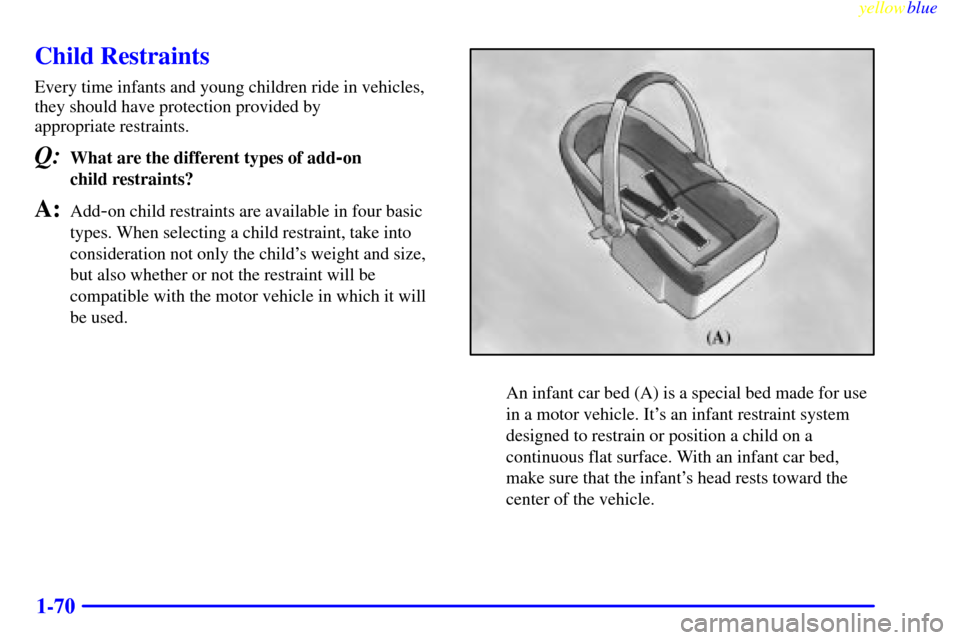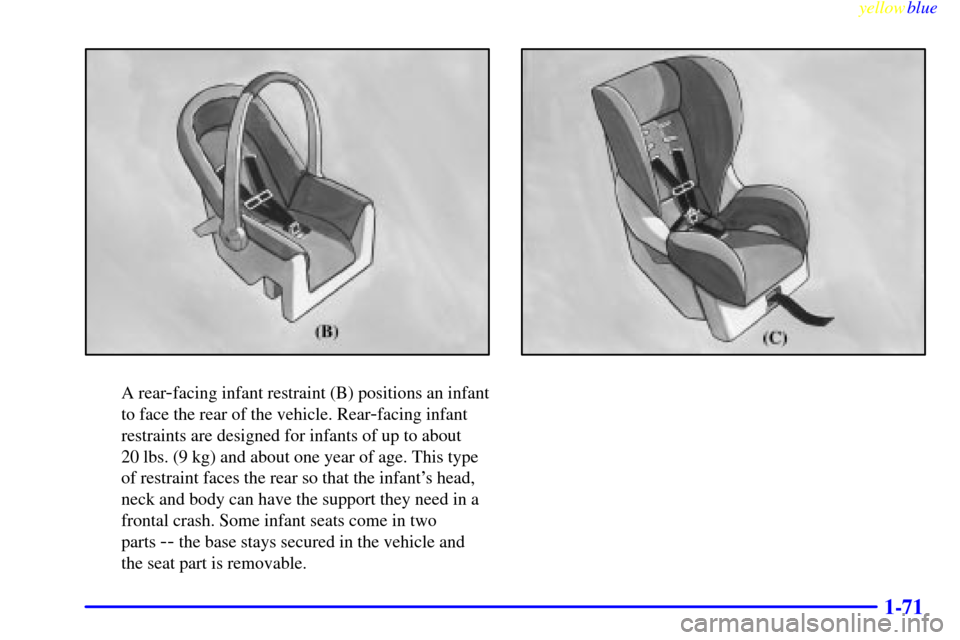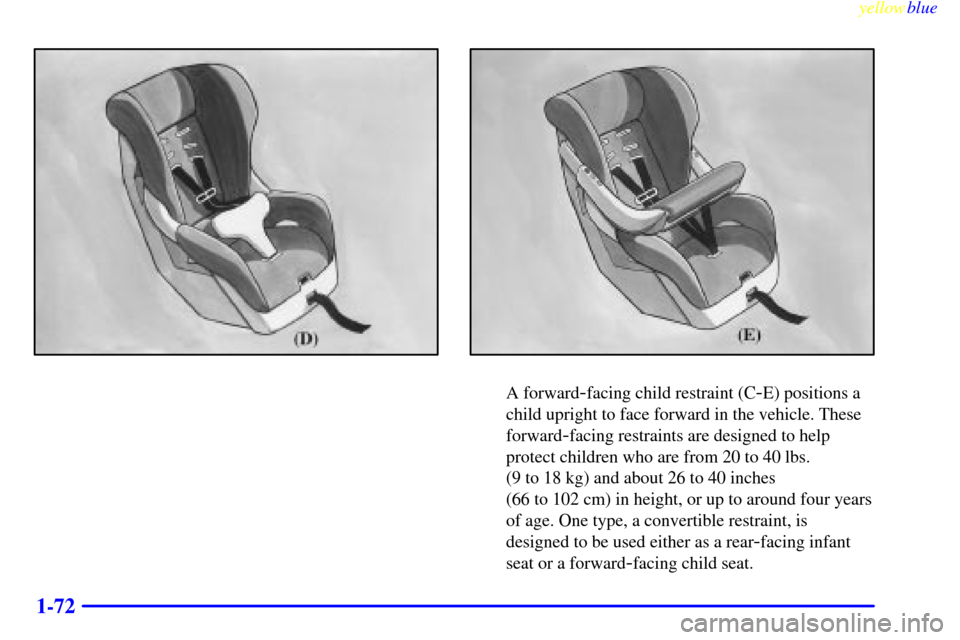CHEVROLET VENTURE 1999 1.G Manual PDF
VENTURE 1999 1.G
CHEVROLET
CHEVROLET
https://www.carmanualsonline.info/img/24/8383/w960_8383-0.png
CHEVROLET VENTURE 1999 1.G Manual PDF
Trending: oil capacity, check engine light, diagram, fuse box, stop start, clock setting, change key battery
Page 71 of 440
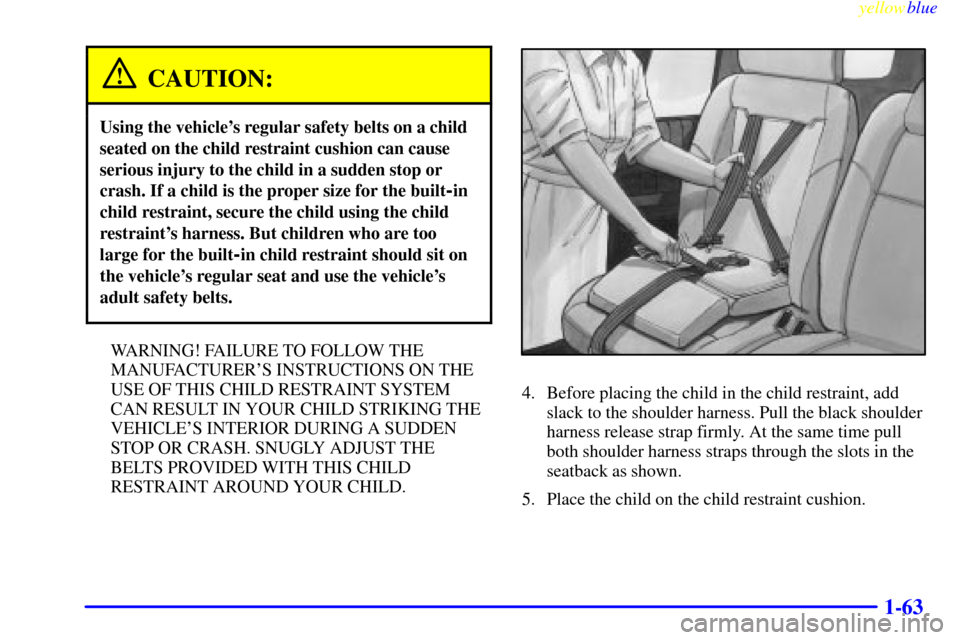
yellowblue
1-63
CAUTION:
Using the vehicle's regular safety belts on a child
seated on the child restraint cushion can cause
serious injury to the child in a sudden stop or
crash. If a child is the proper size for the built
-in
child restraint, secure the child using the child
restraint's harness. But children who are too
large for the built
-in child restraint should sit on
the vehicle's regular seat and use the vehicle's
adult safety belts.
WARNING! FAILURE TO FOLLOW THE
MANUFACTURER'S INSTRUCTIONS ON THE
USE OF THIS CHILD RESTRAINT SYSTEM
CAN RESULT IN YOUR CHILD STRIKING THE
VEHICLE'S INTERIOR DURING A SUDDEN
STOP OR CRASH. SNUGLY ADJUST THE
BELTS PROVIDED WITH THIS CHILD
RESTRAINT AROUND YOUR CHILD.
4. Before placing the child in the child restraint, add
slack to the shoulder harness. Pull the black shoulder
harness release strap firmly. At the same time pull
both shoulder harness straps through the slots in the
seatback as shown.
5. Place the child on the child restraint cushion.
Page 72 of 440
yellowblue
1-64
6. Select only one side of the harness. Place the harness
over the child's shoulder.
7. Push the latch plate (B) into the buckle until it clicks.
Be sure the buckle is free of any foreign objects that
may prevent you from securing the latch plates. If
you can't secure a latch plate, see your dealer for
service before using the child restraint.8. Place the other side of the harness over the
child's shoulder.
9. Push the latch plate into the buckle until it clicks.
10. Pull up on both latch plates to make sure they
are secure.
Page 73 of 440
yellowblue
1-65
11. Now fasten the left and right halves of the shoulder
harness clip together. The purpose of this clip is to
help keep the harness positioned on the
child's shoulders.
CAUTION:
An unfastened shoulder harness clip won't help
keep the harness in place on the child's shoulders.
If the harness isn't on the child's shoulders, it
won't be able to restrain the child's upper body
in a sudden stop or crash. The child could be
seriously injured. Make sure the harness clip is
properly fastened.
Page 74 of 440
yellowblue
1-66
12. Pull the shoulder harness adjustment strap (C)
firmly until the harness is snugly adjusted around
the child. You should not be able to put more than
two fingers between the harness and the child's
chest. Make sure the harness and buckle strap are
not twisted.13. Adjust the position of the harness on the child's
shoulder by moving the clip up or down along the
harness. On each side of the harness, the shoulder
part should be centered on the child's shoulder. The
harness should be away from the child's face and
neck, but not falling from the child's shoulders.
If you expect that the child will sleep while riding,
you can recline the seatback. See ªSeatsº in
the Index.
Page 75 of 440
yellowblue
1-67 Removing the Child from the Built-In
Child Restraint
1. Unfasten the shoulder harness clip.
2. Unlatch the harness by pushing the button on
the buckle.
3. Move one side of the harness off the child's shoulder.
4. Move the other side of the harness off the
child's shoulder.
5. Remove the child from the child restraint cushion.
Page 76 of 440
yellowblue
1-68 Storing the Built-In Child Restraint
Always properly store the built-in child restraint before
using the vehicle's lap
-shoulder belt.
1. Move both latch plates and both sides of the shoulder
harness clip to the bottom of the harness straps.
2. Fold the child restraint cushion and leg rest up into
the seatback.
3. Press the child restraint cushion firmly into
the seatback.
Page 77 of 440
yellowblue
1-69
4. Then press the leg rest firmly into the seatback, and
secure it by pressing the upper corners against the
fastener strips on the seatback.5. Rotate the head restraint forward and push it all the
way down.
Just like the other restraint systems in your vehicle, your
built
-in child restraint needs to be periodically checked
and may need to have parts replaced after a crash. See
ªChecking Your Restraint Systemsº and ªReplacing Seat
and Restraint System Parts After a Crashº in the Index.
Page 78 of 440
yellowblue
1-70
Child Restraints
Every time infants and young children ride in vehicles,
they should have protection provided by
appropriate restraints.
Q:What are the different types of add-on
child restraints?
A:Add-on child restraints are available in four basic
types. When selecting a child restraint, take into
consideration not only the child's weight and size,
but also whether or not the restraint will be
compatible with the motor vehicle in which it will
be used.
An infant car bed (A) is a special bed made for use
in a motor vehicle. It's an infant restraint system
designed to restrain or position a child on a
continuous flat surface. With an infant car bed,
make sure that the infant's head rests toward the
center of the vehicle.
Page 79 of 440
yellowblue
1-71
A rear-facing infant restraint (B) positions an infant
to face the rear of the vehicle. Rear
-facing infant
restraints are designed for infants of up to about
20 lbs. (9 kg) and about one year of age. This type
of restraint faces the rear so that the infant's head,
neck and body can have the support they need in a
frontal crash. Some infant seats come in two
parts
-- the base stays secured in the vehicle and
the seat part is removable.
Page 80 of 440
yellowblue
1-72
A forward-facing child restraint (C-E) positions a
child upright to face forward in the vehicle. These
forward
-facing restraints are designed to help
protect children who are from 20 to 40 lbs.
(9 to 18 kg) and about 26 to 40 inches
(66 to 102 cm) in height, or up to around four years
of age. One type, a convertible restraint, is
designed to be used either as a rear
-facing infant
seat or a forward
-facing child seat.
Trending: suspension, length, light, octane, power steering, coolant, gas mileage

